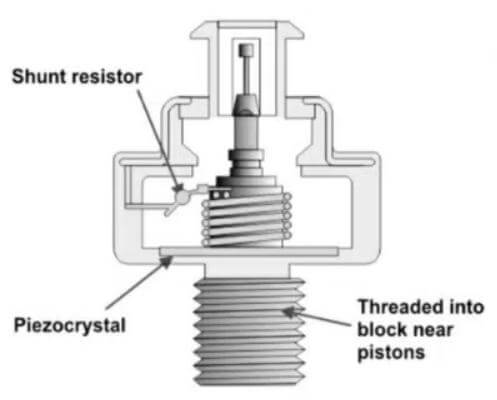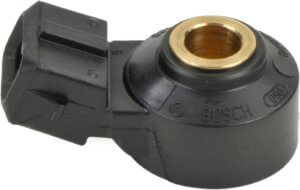Knock sensor symptoms
The three most common knock sensor symptoms
The computer constantly checks the knock sensor and sets a check engine light if it fails. But you can also get these knock sensor symptoms.
A knock sensor code will turn on the check engine light
The code can be caused by a faulty knock sensor or a knock sensor wiring harness issue.
You may notice pinging from the engine under heavy acceleration
Pre-ignition causes the air/fuel mixture to start combustion before the spark plug fires. The knock sensor detect pinging and the ECU is supposed to alter ignition timing to reduce pinging. If the knock sensor isn’t working properly, you’ll hear more pining. A knock sensor can also detect detonation, a rapid pressure rise and multiple colliding flame fronts that occurs after the spark plug first and the piston is on the power stroke.
You’ll notice lower engine performance
Pre-ignition and detonation reduce engine power, especially when you are under load. So you’ll notice
• Poor acceleration
• Power Loss
How does a knock sensor work?
The knock sensors’ job is to detect irregular vibrations of the engine. The irregular vibrations are caused by uneven combustion; either pre-ignition or detonation.
There are two types of knock sensors: inductive resonant sensors, piezoelectric resonant.
Resonant knock sensor
A resonant knock sensor contains a vibration plate designed to  match the same resonant frequency as the shock/vibration of pre-ignition or detonation knock. When the knocking occurs, the vibration plate reaches its maximum vibration amplitude and that vibration is converted into an electrical signal; either through an electromagnetic induction or the piezoelectric effect. Due to the narrow band response, the resonant sensor can only detect certain engine knock frequencies.
match the same resonant frequency as the shock/vibration of pre-ignition or detonation knock. When the knocking occurs, the vibration plate reaches its maximum vibration amplitude and that vibration is converted into an electrical signal; either through an electromagnetic induction or the piezoelectric effect. Due to the narrow band response, the resonant sensor can only detect certain engine knock frequencies.
Piezoelectric Non-resonant Sensor
This type uses a spring method to measure vibration directly, so the frequency band (typically 5 kHz to 15 kHz) is wider. Knock frequency can vary slightly with engine speed, so non-resonant sensors generally perform better than resonant sensors. Vibration-based knock sensors are usually mounted on the cylinder block or cylinder head.s waveform.
What causes an engine knock large enough to set a knock sensor code?
Pre-ignition (PING) can cause a knock sensor code
Pre-ignition occurs when combustion starts before the spark plug has fired. When the spark plug fires and ignites the fuel, the two flame fronts collide, creating a knocking sound.
What causes pre-ignition?
• Glowing carbon buildup in the cylinder head ignites the fuel before the spark event.
• Incorrect spark plug heat range that prevents the spark plug from cooling properly—allows the spark plug to retain too much heat
• Running low octane fuel in a high compression engine that requires a high octane fuel
Detonation can cause a knock sensor code
Detonation occurs at the end of the combustion cycle when a rapid rise in heat and pressure causes multiple pockets of unburned fuel to ignite and collide.
What causes detonation?
Fueling with low octane fuel in an engine that requires hi octane fuel
How does the ECU test the knock sensor?
The ECU periodically tests the knock sensor by altering the air/fuel mixture and ignition timing to purposely produce a knock or ping. If the ECU doesn’t see a corresponding knock detection signal from the knock sensor, it sets one or more of these trouble codes.
P0325 Knock Sensor 1 Circuit Malfunction (Bank I or Single Sensor)
P0326 Knock Sensor 1 Circuit Range/Performance (Bank 1 or Single Sensor)
P0327 Knock Sensor 1 Circuit Low Input (Bank I or Single Sensor)
P0328 Knock Sensor 1 Circuit High Input (Bank I or Single Sensor)
P0329 Knock Sensor 1 Circuit Intermittent (Bank 1 or Single Sensor)
P0330 Knock Sensor 2 Circuit Malfunction (Bank 2)
P0331 Knock Sensor 2 Circuit Range/Performance (Bank 2)
P0332 Knock Sensor 2 Circuit Low Input (Bank 2)
P0333 Knock Sensor 2 Circuit High Input (Bank 2)
How to fix a knock sensor code
A faulty knock sensor is the most common cause of a knock sensor code. However, before automatically changing out the knock sensor, inspect the wiring harness and connector for signs of rodent damage, corrosion, chaffing, or even disconnection.
Knock sensor replacement
The sensor orientation must be correct
Before removing the faulty knock sensor, note it’s orientation on the top of the engine. The new sensor must be installed in the exact same orientation. Failure to do this can cause additional knock sensor codes.
Use a torque wrench
Using a torque wrench when installing the hold down bolt is critical to proper knock sensor operation. Refer to a shop manual for the torque spec and sensor orientation.
©, 2022 Rick Muscoplat
Posted on by Rick Muscoplat
